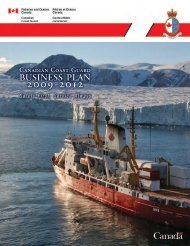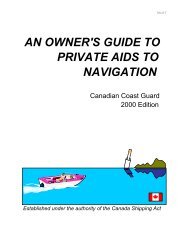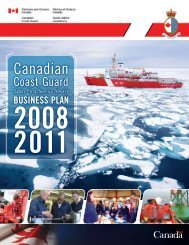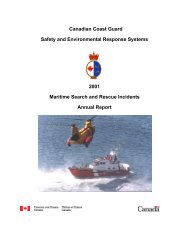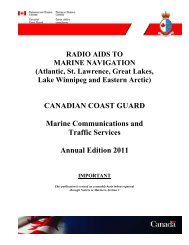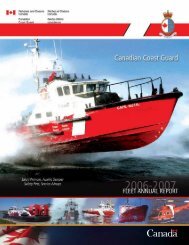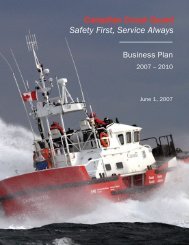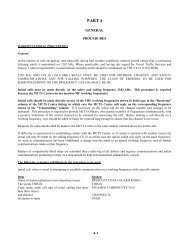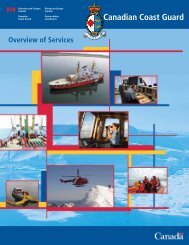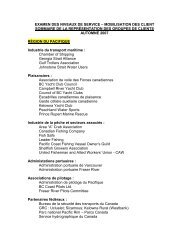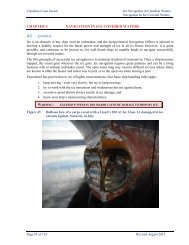RADIO AIDS TO MARINE NAVIGATION - Canadian Coast Guard
RADIO AIDS TO MARINE NAVIGATION - Canadian Coast Guard
RADIO AIDS TO MARINE NAVIGATION - Canadian Coast Guard
You also want an ePaper? Increase the reach of your titles
YUMPU automatically turns print PDFs into web optimized ePapers that Google loves.
The radiotelephone distress frequencies are:<br />
i) 2182 kHz on medium frequency (MF) band; and<br />
ii) 156.8 MHz (ch 16) on very high frequency band (VHF); and<br />
iii) any other available frequency on which attention might be attracted if transmissions on 2182 kHz and 156.8 MHz are<br />
not possible or successful.<br />
The digital selective calling (DSC) frequencies are:<br />
i) Channel 70 in the VHF band;<br />
ii) 4207.5 kHz;<br />
iii) 6312.0 kHz;<br />
iv) 8414.5 kHz;<br />
v) 12577 kHz; and<br />
vi) 16804.5 kHz in the High Frequency (HF) bands.<br />
When another craft or person is in distress:<br />
i) all transmissions capable of interfering with the distress traffic must be stopped;<br />
ii) attention must be concentrated on the distress communications and all information possible intercepted; and<br />
iii) a station in the vicinity of the distressed craft must acknowledge receipt of the distress message if received, giving its<br />
own position in relation to that of the craft in distress and stating the action being taken.<br />
Distress communications consist of the:<br />
• Distress Signal;<br />
• Distress Call;<br />
• Distress Message; and<br />
• Distress Traffic.<br />
Transmission of a Distress Signal and/or a Distress Call announces that the ship, aircraft, other vehicle, or person that is<br />
making the transmission is:<br />
i) threatened by serious and imminent danger and requires immediate assistance; or<br />
ii) aware of another ship, aircraft, other vehicle or person is threatened by serious and imminent danger and requires<br />
immediate assistance; and<br />
iii) distress communications should be repeated by the craft in distress until an answer is heard.<br />
The Alarm Signal<br />
The radiotelephone Alarm Signal consists of the continuous alternate transmission of two audio tones of different pitch for<br />
a period of at least thirty seconds but not to exceed one minute. The sound of this tone is similar to that used by some<br />
ambulances.<br />
The Alarm Signal is used by <strong>Canadian</strong> MCTS Centres to alert ships:<br />
i) that a mayday relay broadcast is about to follow; or<br />
ii) that a Tsunami warning, which should be preceded by the Urgency Signal (PAN PAN) is about to follow; or,<br />
iii) that the transmission of an urgent cyclone warning, which should be preceded by the Safety Signal (SÉCURITÉ), is<br />
about to follow.<br />
The Alarm Signal transmitted by the coast radio station will normally be sent for a period not exceeding thirty (30) seconds<br />
and will be followed by a ten (10) second continuous tone.<br />
The Distress Signal consists of the word “MAYDAY”.<br />
The Distress Call consists of:<br />
i) the word “MAYDAY” (spoken three times)<br />
ii) the words “This is” followed by<br />
iii) the name of the ship in distress (spoken three times) and<br />
iv) the ship’s MMSI number (if a DSC distress alert has been sent).<br />
The Distress Call:<br />
i) should not be addressed to a particular coast radio station or ship; and<br />
4-5



